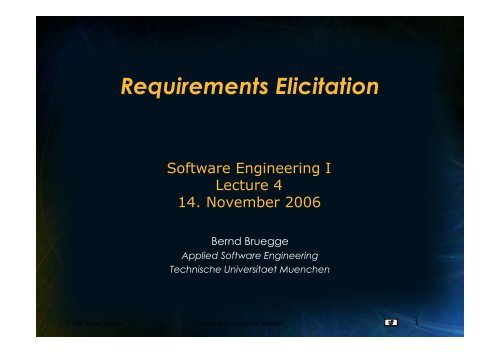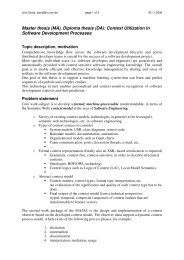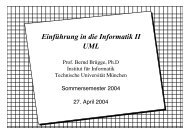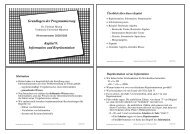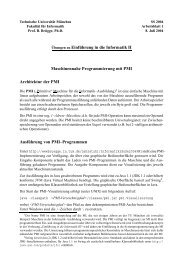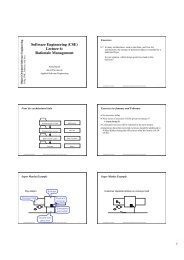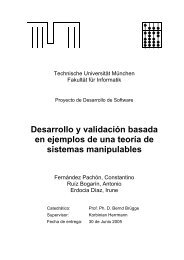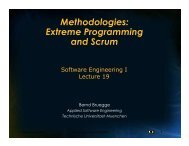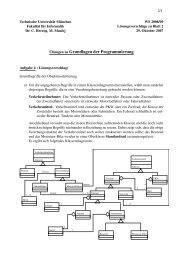Requirements Elicitation - Chair for Applied Software Engineering
Requirements Elicitation - Chair for Applied Software Engineering
Requirements Elicitation - Chair for Applied Software Engineering
Create successful ePaper yourself
Turn your PDF publications into a flip-book with our unique Google optimized e-Paper software.
<strong>Requirements</strong> <strong>Elicitation</strong><strong>Software</strong> <strong>Engineering</strong> ILecture 414. November 2006Bernd Bruegge<strong>Applied</strong> <strong>Software</strong> <strong>Engineering</strong>Technische Universitaet Muenchen© 2006 Bernd Bruegge <strong>Software</strong> <strong>Engineering</strong> WS 2006/20071
First step in identifying the <strong>Requirements</strong>:System identification• Two questions need to be answered:1. How can we identify the purpose of a system?2. What is inside, what is outside the system?• These two questions are answered duringrequirements elicitation and analysis• <strong>Requirements</strong> elicitation:• Definition of the system in terms understood by thecustomer (“<strong>Requirements</strong> specification”)• Analysis:• Definition of the system in terms understood by thedeveloper (Technical specification, “Analysismodel”)© 2006 Bernd Bruegge <strong>Software</strong> <strong>Engineering</strong> WS 2006/20074
What does the Customer say?© 2006 Bernd Bruegge <strong>Software</strong> <strong>Engineering</strong> WS 2006/20075
Defining the System Boundary is difficultWhat do you see here?© 2006 Bernd Bruegge <strong>Software</strong> <strong>Engineering</strong> WS 2006/20076
Defining the System Boundary is difficultWhat do you see now?© 2006 Bernd Bruegge <strong>Software</strong> <strong>Engineering</strong> WS 2006/20077
Defining the System Boundary is difficultWhat do you see now?© 2006 Bernd Bruegge <strong>Software</strong> <strong>Engineering</strong> WS 2006/20078
Ambiguous SpecificationDuring a laser experiment, a laser beam wasdirected at a mirror on the Space ShuttleDiscoveryThe laser beam was supposed to be reflectedback towards a mountain top 10,023 feet high.The operator entered the elevation as “10023”The computer interpreted the number in miles...© 2006 Bernd Bruegge <strong>Software</strong> <strong>Engineering</strong> WS 2006/200710
Unintended FeatureFrom the News: London underground trainleaves station without driver!What happened?• A passenger door was stuck and did not close• The driver left his train to close the door• Be<strong>for</strong>e leaving the train, he tightens the startbutton on the console with tape• He relied on the specification that preventsthe train from moving if a door is open• When he shut the passenger door,the train left the station without him.© 2006 Bernd Bruegge <strong>Software</strong> <strong>Engineering</strong> WS 2006/200711
Techniques to elicit <strong>Requirements</strong>• Bridging the gap between end user anddeveloper:• Questionnaires: Asking the end user a list of preselectedquestions• Task Analysis: Observing end users in theiroperational environment• Scenarios: Describe the use of the system as a seriesof interactions between a concrete end user and thesystem• Use cases: Abstractions that describe a class ofscenarios• <strong>Requirements</strong> Process: Contains the activities<strong>Requirements</strong> <strong>Elicitation</strong> and Analysis.© 2006 Bernd Bruegge <strong>Software</strong> <strong>Engineering</strong> WS 2006/200712
<strong>Requirements</strong> Process:problemstatement<strong>Requirements</strong>elicitation<strong>Requirements</strong>Specification:nonfunctionalrequirements:functionalmodelAnalysisAnalysis Model:dynamic modelUML Activity Diagram:analysis objectmodel© 2006 Bernd Bruegge <strong>Software</strong> <strong>Engineering</strong> WS 2006/200713
<strong>Requirements</strong> Specification vs AnalysisModelBoth focus on the requirements from the user’sview of the system• The requirements specification uses naturallanguage (derived from the problem statement)• The analysis model uses a <strong>for</strong>mal or semi-<strong>for</strong>malnotation (<strong>for</strong> example, UML).© 2006 Bernd Bruegge <strong>Software</strong> <strong>Engineering</strong> WS 2006/200714
Types of <strong>Requirements</strong>• Functional requirements• Describe the interactions between the system and itsenvironment independent from the implementation“An operator should be able to define a new game. “• Nonfunctional requirements• Aspects not directly related to functional behavior.“The response time must be less than 1 second”• Constraints• Imposed by the client or the environment• “The implementation language must be Java “• Called “Pseudo requirements” in the text book.© 2006 Bernd Bruegge <strong>Software</strong> <strong>Engineering</strong> WS 2006/200715
Functional vs. Nonfunctional <strong>Requirements</strong>Functional <strong>Requirements</strong>• Describe user tasksthat the system needsto support• Phrased as actions“Advertise a new league”“Schedule tournament”“Notify an interest group”Nonfunctional <strong>Requirements</strong>• Describe properties of thesystem or the domain• Phrased as constraints ornegative assertions“All user inputs should beacknowledged within 1second”“A system crash should notresult in data loss”“All actions should beundoable”© 2006 Bernd Bruegge <strong>Software</strong> <strong>Engineering</strong> WS 2006/200716
Types of Nonfunctional <strong>Requirements</strong>Quality requirementsConstraints orPseudo requirements© 2006 Bernd Bruegge <strong>Software</strong> <strong>Engineering</strong> WS 2006/200717
Types of Nonfunctional <strong>Requirements</strong>• Usability• Reliability• Robustness• Safety• Per<strong>for</strong>mance• Response time• Scalability• Throughput• Availability• Supportability• Adaptability• MaintainabilityQuality requirements© 2006 Bernd Bruegge <strong>Software</strong> <strong>Engineering</strong> WS 2006/2007Constraints orPseudo requirements18
Types of Nonfunctional <strong>Requirements</strong>• Usability• Reliability• Robustness• Safety• Per<strong>for</strong>mance• Response time• Scalability• Throughput• Availability• Supportability• Adaptability• MaintainabilityQuality requirements© 2006 Bernd Bruegge <strong>Software</strong> <strong>Engineering</strong> WS 2006/2007• Implementation• Interface• Operation• Packaging• Legal• Licensing• Certification• RegulationConstraints orPseudo requirements19
Some Quality <strong>Requirements</strong> Definitions• Usability• Denotes the ease with which an actor can employ the systemin order to per<strong>for</strong>m a function• Robustness• The ability of the software system to maintain a function even ifthe user enters a wrong input, or there are changes in theinternal structure or environment• Maintainability• The ease with which a function can be changed or improved inaccordance with the requirements• Availability• The ratio of the expected uptime of a system to the aggregateof the expected up and down time.© 2006 Bernd Bruegge <strong>Software</strong> <strong>Engineering</strong> WS 2006/200720
Nonfunctional <strong>Requirements</strong>: ARENAexamples• “Spectators must be able to watch matcheswithout prior registration and without priorknowledge of the match.”Usability Requirement• “The system must support 10 paralleltournaments”Per<strong>for</strong>mance Requirement• “The operator must be able to add new gameswithout modifications to the existing system.”Supportability Requirement© 2006 Bernd Bruegge <strong>Software</strong> <strong>Engineering</strong> WS 2006/200721
What is usually not in the <strong>Requirements</strong>?• System structure, implementation technology• Development methodology• Development environment• Implementation language• Reusability• It is desirable that none of these above areconstrained by the client.© 2006 Bernd Bruegge <strong>Software</strong> <strong>Engineering</strong> WS 2006/200722
<strong>Requirements</strong> Validation<strong>Requirements</strong> validation is a quality assurancestep, usually after requirements elicitation oranalysis• Correctness:• The requirements represent the client’s view• Completeness:• All possible scenarios, in which the system can be used,are described• Consistency:• There are no requirements that contradict each other.© 2006 Bernd Bruegge <strong>Software</strong> <strong>Engineering</strong> WS 2006/200723
<strong>Requirements</strong> Validation (2)• Clarity:• <strong>Requirements</strong> can only be interpreted in one way• Realism:• <strong>Requirements</strong> can be implemented and delivered• Traceability:• Each system behavior can be traced to a set offunctional requirements• Problems with requirements validation:• <strong>Requirements</strong> change quickly during requirementselicitation• Inconsistencies are easily added with each change• Tool support is needed!© 2006 Bernd Bruegge <strong>Software</strong> <strong>Engineering</strong> WS 2006/200724
<strong>Requirements</strong> <strong>for</strong> <strong>Requirements</strong>Management• Tool support <strong>for</strong> managing requirements:• Store requirements in a shared repository• Provide multi-user access• Automatically create a system specificationdocument• Allow change management• Provide traceability of the requirementsthroughout the artifacts of the system.© 2006 Bernd Bruegge <strong>Software</strong> <strong>Engineering</strong> WS 2006/200725
Tools <strong>for</strong> <strong>Requirements</strong> Management (2)DOORS (Telelogic)• Multi-plat<strong>for</strong>m, <strong>for</strong> teams working in the samegeographical location. DOORS XT <strong>for</strong> distributed teamsRequisitePro (IBM/Rational)• Integration with MS Word• Project-to-project comparisons via XML baselinesRD-Link (http://www.ring-zero.com)• Traceability between RequisitePro & Telelogic DOORSSysiphus (http://sysiphus.in.tum.de/)• Research tool <strong>for</strong> the collaborative development ofsystem models• Participants can be in geographically distributedlocations© 2006 Bernd Bruegge <strong>Software</strong> <strong>Engineering</strong> WS 2006/200726
Types of <strong>Requirements</strong> <strong>Elicitation</strong>• Greenfield <strong>Engineering</strong>• Development starts from scratch, no prior systemexists, requirements come from end users and clients• Triggered by user needs• Re-engineering• Re-design and/or re-implementation of an existingsystem using newer technology• Triggered by technology enabler• Interface <strong>Engineering</strong>• Provision of existing services in a new environment• Triggered by technology enabler or new market needs© 2006 Bernd Bruegge <strong>Software</strong> <strong>Engineering</strong> WS 2006/200727
Prioritizing requirements• High priority• Addressed during analysis, design, and implementation• A high-priority feature must be demonstrated• Medium priority• Addressed during analysis and design• Usually demonstrated in the second iteration• Low priority• Addressed only during analysis• Illustrates how the system is going to be used in thefuture with not yet available technology© 2006 Bernd Bruegge <strong>Software</strong> <strong>Engineering</strong> WS 2006/200728
<strong>Requirements</strong> Analysis Document Template1. Introduction2. Current system3. Proposed system3.1 Overview3.2 Functional requirements3.3 Nonfunctional requirements3.4 Constraints (“Pseudo requirements”)3.5 System models3.5.1 Scenarios3.5.2 Use case model3.5.3 Object model3.5.3.1 Data dictionary3.5.3.2 Class diagrams3.5.4 Dynamic models3.5.5 User interfae4. Glossary© 2006 Bernd Bruegge <strong>Software</strong> <strong>Engineering</strong> WS 2006/200729
Section 3.3 Nonfunctional <strong>Requirements</strong>3.3.1 User interface and human factors3.3.2 Documentation3.3.3 Hardware considerations3.3.4 Per<strong>for</strong>mance characteristics3.3.5 Error handling and extreme conditions3.3.6 System interfacing3.3.7 Quality issues3.3.8 System modifications3.3.9 Physical environment3.3.10 Security issues3.3.11 Resources and management issues© 2006 Bernd Bruegge <strong>Software</strong> <strong>Engineering</strong> WS 2006/200730
Nonfunctional <strong>Requirements</strong>(Questions to overcome “Writers block”)User interface and human factors• What type of user will be using the system?• Will more than one type of user be using thesystem?• What training will be required <strong>for</strong> each type ofuser?• Is it important that the system is easy to learn?• Should users be protected from making errors?• What input/output devices are availableDocumentation• What kind of documentation is required?• What audience is to be addressed by eachdocument?© 2006 Bernd Bruegge <strong>Software</strong> <strong>Engineering</strong> WS 2006/200731
Nonfunctional <strong>Requirements</strong> (2)Hardware considerations• What hardware is the proposed system to be used on?• What are the characteristics of the target hardware,including memory size and auxiliary storage space?Per<strong>for</strong>mance characteristics• Are there speed, throughput, response time constraintson the system?• Are there size or capacity constraints on the data to beprocessed by the system?Error handling and extreme conditions• How should the system respond to input errors?• How should the system respond to extreme conditions?© 2006 Bernd Bruegge <strong>Software</strong> <strong>Engineering</strong> WS 2006/200732
Nonfunctional <strong>Requirements</strong> (3)System interfacing• Is input coming from systems outside the proposedsystem?• Is output going to systems outside the proposed system?• Are there restrictions on the <strong>for</strong>mat or medium that mustbe used <strong>for</strong> input or output?Quality issues• What are the requirements <strong>for</strong> reliability?• Must the system trap faults?• What is the time <strong>for</strong> restarting the system after a failure?• Is there an acceptable downtime per 24-hour period?• Is it important that the system be portable?© 2006 Bernd Bruegge <strong>Software</strong> <strong>Engineering</strong> WS 2006/200733
Nonfunctional <strong>Requirements</strong> (4)System Modifications• What parts of the system are likely to be modified?• What sorts of modifications are expected?Physical Environment• Where will the target equipment operate?• Is the target equipment in one or several locations?• Will the environmental conditions be ordinary?Security Issues• Must access to data or the system be controlled?• Is physical security an issue?© 2006 Bernd Bruegge <strong>Software</strong> <strong>Engineering</strong> WS 2006/200734
Nonfunctional <strong>Requirements</strong> (5)Resources and Management Issues• How often will the system be backed up?• Who will be responsible <strong>for</strong> the back up?• Who is responsible <strong>for</strong> system installation?• Who will be responsible <strong>for</strong> system maintenance?© 2006 Bernd Bruegge <strong>Software</strong> <strong>Engineering</strong> WS 2006/200735


